Settings
BusyCal's Settings window offers numerous ways to configure its appearance and behavior to suit your needs.
To display the Settings window, choose BusyCal > Settings (also known as "Preferences" on earlier macOS versions). Then click the icon at the top corresponding to the category of preference you want to adjust.
General
To customize the start of the week, number of days or weeks shown, day start and end times, and other settings, click General.
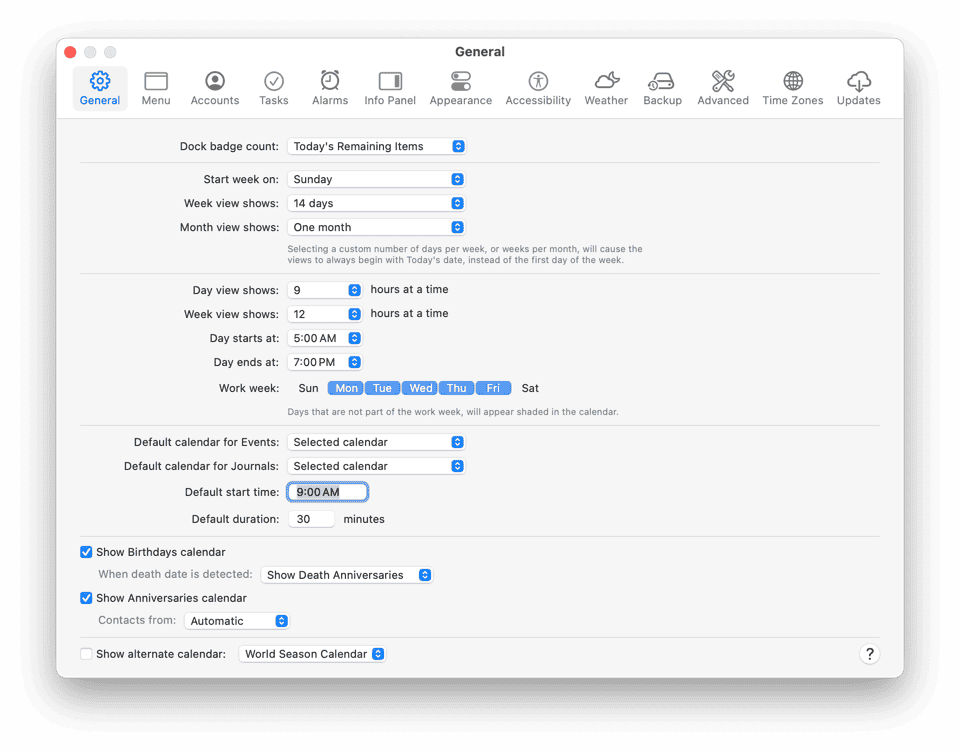
Amongst several settings, you can adjust the following options in General Settings:
- Start week on — The first day displayed in the leftmost column of the Week/Month view.
This setting only determines which day appears first in the Week/Month view. It does not control how BusyCal pins to a specific day in Week View. If you want the week to always start on the same day regardless of the current weekday, set Week view shows (explained below) to One Week instead of a custom number of days. Watch demo to understand the difference.
-
Week view shows — Controls how many days are displayed in the Week view (2–14).
- If One week or Two weeks is selected, the leftmost column always starts on the Start week on setting above.
- If a custom range (2–14 days) is selected, the leftmost column begins with today, allowing you to focus on upcoming days.
-
Month view shows — Controls how many weeks are displayed in the Month view (1–12).
- If One month is selected, a traditional month view is shown with the 1st of the month in the topmost row.
- If a custom range (1–12 weeks) is selected, the topmost row starts with the current week and shows x weeks forward, making it easier to focus on upcoming weeks.
-
Day and Week views show — Determines the number of hours shown (i.e., the zoom level) in the Day/Week view.
While in Day/Week view, you can dynamically set the hours shown by holding down Option and scrolling with a mouse scroll wheel, two-finger swiping up or down on a trackpad, or one-finger swiping up or down on a Magic Mouse.
-
Day starts at — Shade the times before the start of day in Day view and Week View.
-
Day ends at — Shade the times after the end of day in Day view and Week View.
-
Default calendar for Events — The default calendar for new events.
-
Default calendar for Journals — The default calendar for new journal entries.
-
Default start time — The default start time for new events.
-
Default duration — The default duration for new events.
-
Show Birthdays calendar — See Birthdays and Anniversaries.
-
Show Anniversaries calendar — See Birthdays and Anniversaries.
Menu
These settings are for the BusyCal Menu & Alarm helper extension. The menu-bar app can run all the time in the background to display alarms as well as upcoming events.
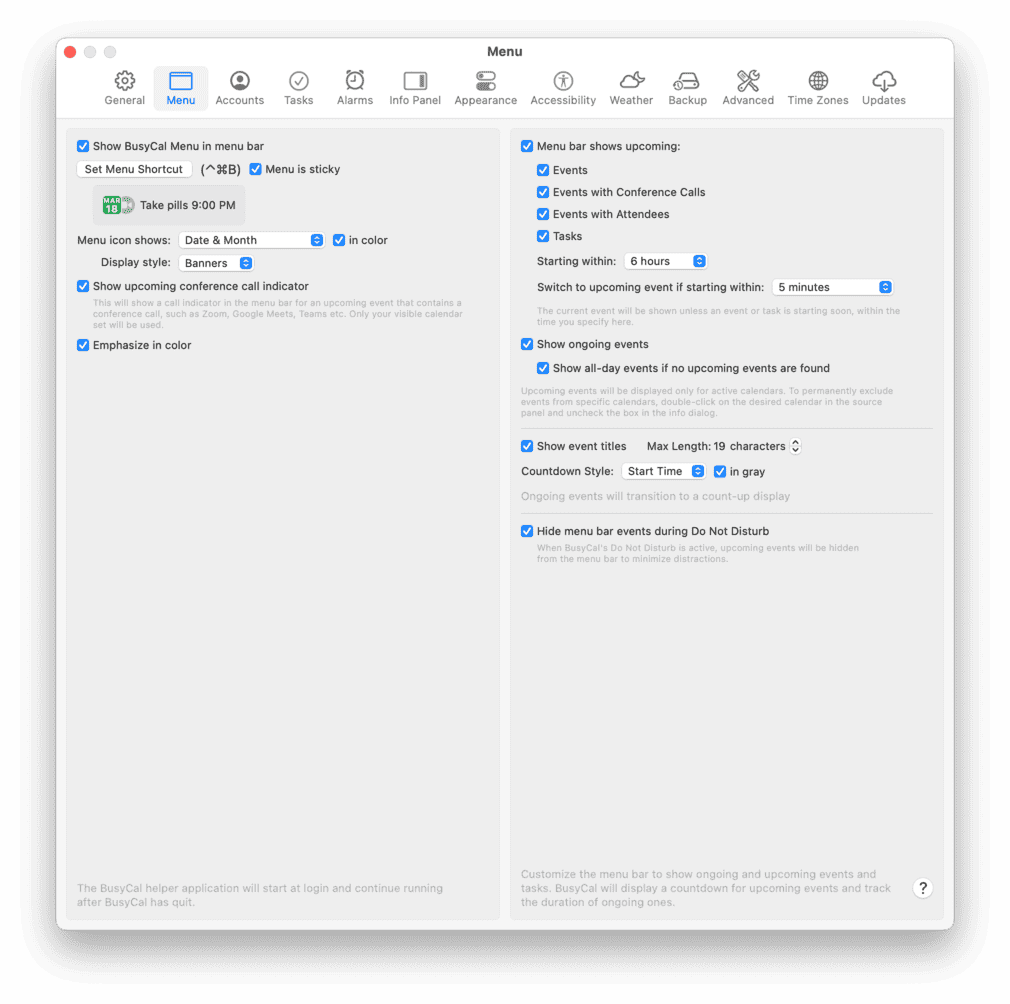
- Show BusyCal Menu in menu bar — See BusyCal Menu & Alarm.
- Menu is sticky — When this checkbox is selected and you display the BusyCal Menu, it continues to float above all other windows and applications until you explicitly dismiss it by clicking the BusyCal Menu icon again. When this checkbox is deselected, clicking anywhere outside the BusyCal Menu or pressing Esc dismisses the menu.
- Set Menu Shortcut — By default, you can press
⌘-Control-Bto display the BusyCal Menu (as an alternative to clicking the menu bar icon). If you prefer to use a different keyboard shortcut (for example, if you’ve already assigned⌘-Control-Bto something else), click Set Menu Shortcut, click in the field at the top of the dialog that appears, and press the key combination you want to use to open the BusyCal Menu. Then click OK.
The Menu bar shows upcoming options allow you to control how upcoming and ongoing events get displayed in the menu bar. By default, BusyCal hides upcoming events when you turn on Do Not Disturb within BusyCal. You can uncheck this option to continue showing your upcoming events at all times.
Accounts
To add or modify calendar accounts (including iCloud, Google, Exchange, and other CalDAV accounts), click Accounts.
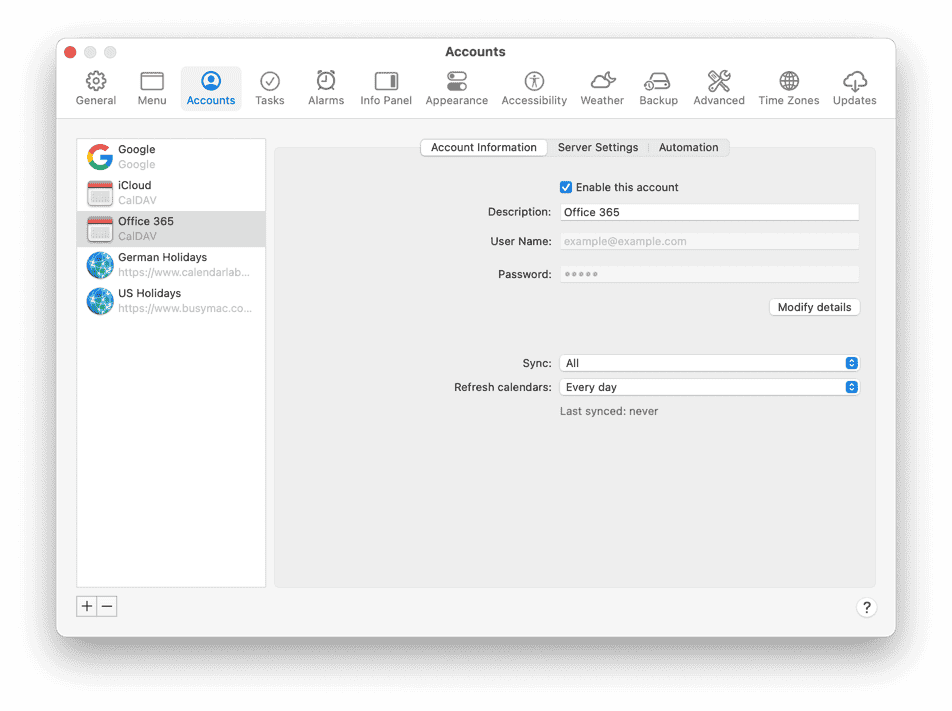
You can then click + (plus) near the bottom left corner to add an account, or select an account and click - (minus) to delete it.
For information on adding and configuring various account types, refer to the following pages:
- iCloud: Syncing with iCloud
- Google: Syncing with Google Calendar
- Exchange: Syncing with Exchange (also covers syncing with Office 365, but note that only business and educational subscriptions to Office 365 include full Exchange support)
- CalDAV: Syncing with a CalDAV Server
- BusyCal over LAN: Sharing calendars on a LAN via Bonjour
The following two options appear only when the account in question supports these:
- Meeting calendar — Meeting invites sent by others will be added to this calendar by default.
- Meeting organizer email — Certain accounts allow you to specify aliases or additional email addresses as part of your primary account, such as iCloud and Fastmail. In case you have several aliases available in your account, you can pick the email address you would like to send meeting invites as (i.e. meeting invites will be sent out with the selected email as the Organizer).
- Minimum supported TLS — Some accounts will show this additional setting. TLS is a cryptographic protocol that provides end-to-end security of data sent between applications over the Internet. This is for advanced users. Setting this to Automatic is recommended, unless your server only supports a particular version of TLS, in which case you should set it to the minimum version it supports.
Automation
Tags can be automatically assigned to events as these are pulled during sync. See Automatic Tagging for more information.
Tasks
To customize how tasks are created and displayed, click Tasks.
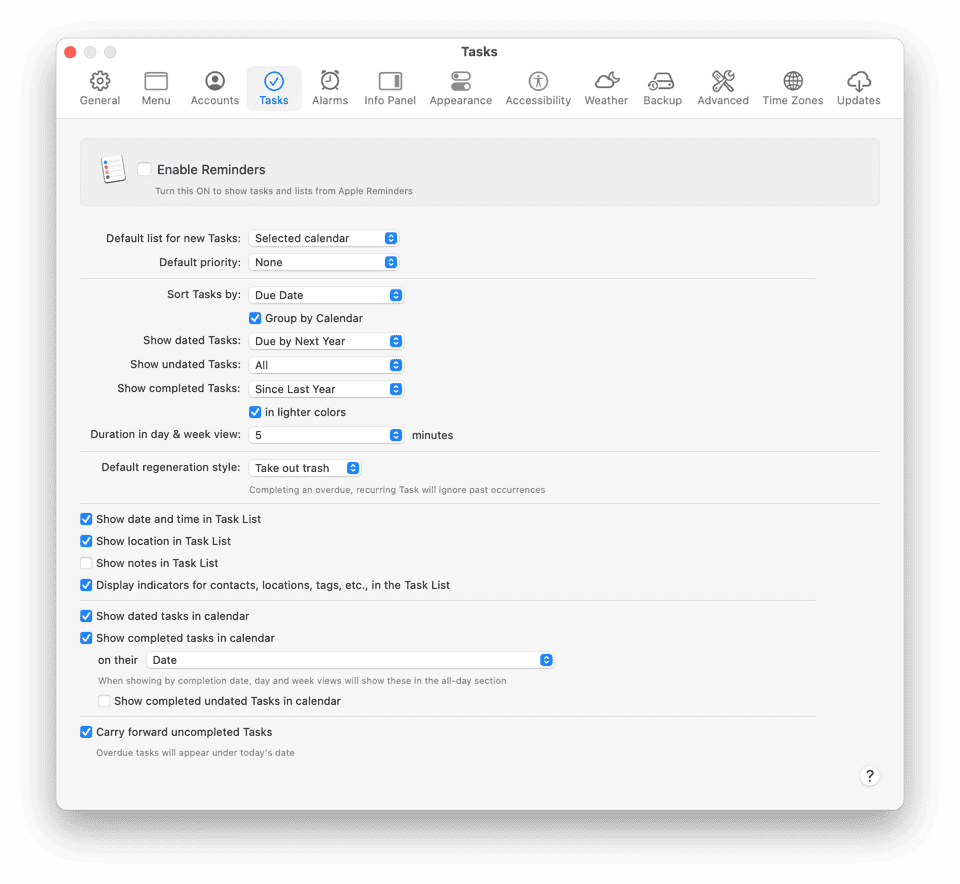
- Enable Reminders — Turn on to sync directly with the Reminders app. This has now become necessary if you have upgraded your Reminders app starting Catalina / iOS 13 as To-Do calendars no longer sync via your iCloud account like before.
The following options are available for customizing tasks:
- Default Calendar for Tasks — The default calendar new tasks are created in.
The following four settings affect the Task List that appears in the right sidebar.
- Sort Task List by — The sort order for the Task List. You can check the 'Group by Calendar' option to apply a secondary grouping to your ToDos by calendar. This way, all the Home Todos, for instance, will group together.
- Show dated Tasks — The date range for tasks displayed in the Task List. The default displays tasks due within the next month. You can select a different range if you want to view fewer or more tasks.
- Show undated Tasks — Whether to display undated tasks in Task List.
- Show completed Tasks — The date range for completed tasks displayed in the Task List. The default displays tasks completed today. You can select a different range if you want to view fewer or more completed tasks.
The following setting affects the visual display of Tasks in Day and Week view:
- Duration in day & week view — The amount of vertical space each To-Do occupies visually in the time line.
The following setting affects regeneration of recurring Tasks when marked done. This is a global setting that applies to all repeating tasks and cannot be applied separately to individual tasks (given this feature is not supported by iCloud / Google / Exchange etc).
- Default regeneration style — The default
Take out trashregeneration style ignores all overdue occurrences and sets the next occurrence to a future date based on the task's due date. For example, you have a to-do to "Take out trash" due daily. The last time you took out the trash was two days ago, before you went away for the weekend. If you take out trash today and mark this, now overdue, to-do as complete, the next occurrence will be set to "Tomorrow" since all of the trash has been taken out.
The Pay rent style, on the other hand, does not skip any overdue occurrence, and sets the next occurrence based on the task's due date. If there's an overdue weekly subscription you haven't paid for several weeks, marking it complete would set its due date to next week from the date it was last due. You would need to explicitly mark each occurrence as complete.
Conversely, with the Pay Rent option set, completing an overdue "Take out trash" to-do would have re-created a todo and set its due date to "Yesterday". Marking that complete would have moved it to "Today" and so on.
The Completion date style will simply set the next occurrence based on the completion date. So if the task was due on the 1st of Oct, set to repeat weekly and is completed on the 5th, the next occurrence will be 12th of Oct (5th + 7 days) instead of the 8th.
Several task management apps prefer to follow the Pay rent style by default, whereas Apple Reminders follows the "Take out trash" regeneration style as its default. BusyCal offers its users the flexibility to choose between the three styles. This is a global setting — see Default regeneration style above for more details.
The following two settings affect Tasks that appear in the calendar:
- Show dated Tasks in calendar — Whether to display dated tasks in the calendar on their due dates.
- Show completed Tasks in calendar — Whether to display completed tasks in the calendar on the dates they are completed.
The following setting affects the display of tasks in both the Task List and calendar:
- Carry forward uncompleted Tasks — Whether to carry forward past due tasks and display them on the current date.
Alarms
To adjust default settings for alarms and the behavior of the BusyCal Alarms window, click Alarms. The right portion of this settings screen addresses default alarms, while the left half applies to the BusyCal Alarm window and related settings.
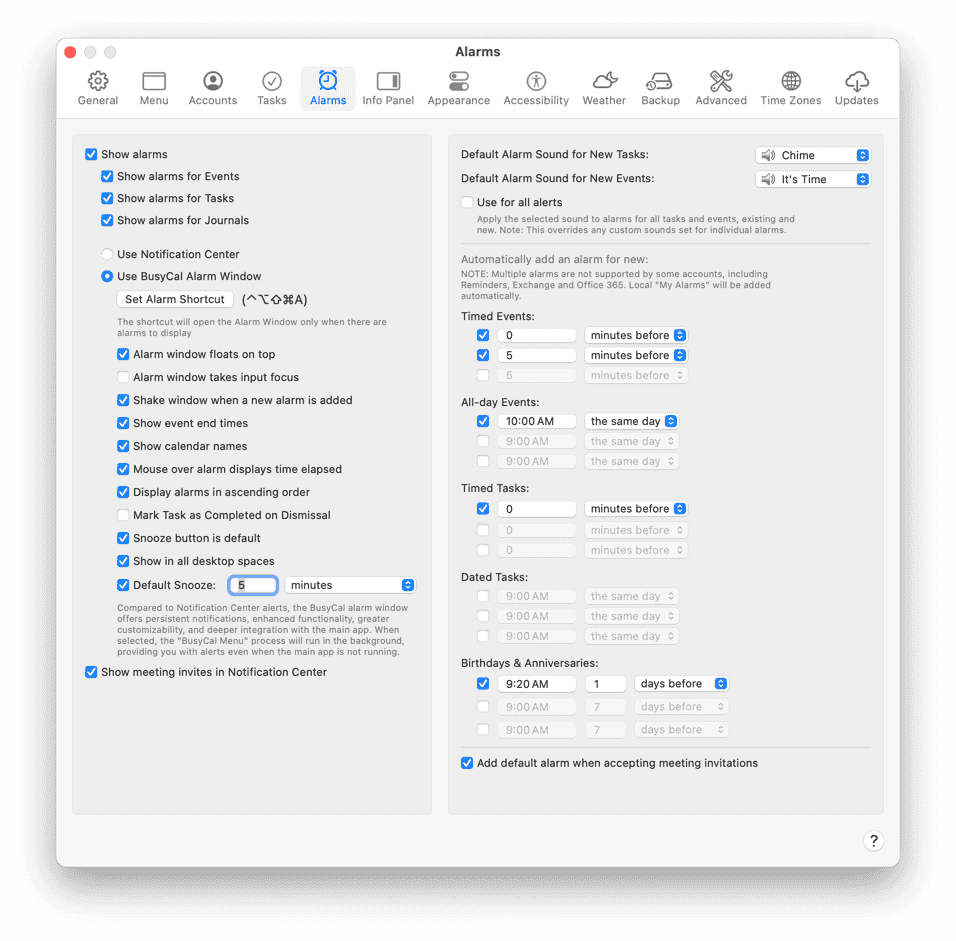
Default Alarms
Although you can manually set alarms for any event or task, you may want to adjust the default settings for new events and tasks to suit your personal preferences.
You can adjust the following settings:
- Default Alarm Sound — From this pop-up menu, choose the sound that will play when an alarm occurs. You can choose a different sound for Tasks vs. Events.
- Use for all alerts — When enabled, the selected sound will override any custom alert sounds that may have been set within individual event notifications. This ensures a consistent alarm sound for all events, regardless of whether they were synced with a different, embedded sound preference.
- Add a default alarm to new timed Events — Select this checkbox to include an alarm by default when creating new timed events. Then enter a number and choose a time period (such as “minutes before” or “hours after”) from the pop-up menu.
- Add a default alarm to new all-day Events — Select this checkbox to include an alarm by default when creating new all-day events. Then enter a time and choose “same day” from the pop-up menu, or choose “days before” or “days after” and enter the number of days before or after the event’s scheduled date when the alarm should occur.
- Add a default alarm to new timed Tasks — Select this checkbox to include an alarm by default when creating new timed tasks. Then enter a number and choose a time period (such as “minutes before” or “hours after”) from the pop-up menu.
- Add a default alarm to new dated Tasks — Select this checkbox to include an alarm by default when creating new timed tasks. Then enter a time and choose “same day” from the pop-up menu, or choose “days before” or “days after” and enter the number of days before or after the task’s scheduled date when the alarm should occur.
- Default alarm for birthdays & anniversaries — Select this checkbox to include an alarm by default for all birthdays and anniversaries. Then enter a time and choose “same day” from the pop-up menu, or choose “days before” or “days after” and enter the number of days before or after the event’s scheduled date when the alarm should occur.
- Add default alarm when accepting meeting invitations — When enabled, any meeting invitation you accept will automatically include your default alarm preference, ensuring you never miss an important event.
Alarm Window
To enable the BusyCal Alarm window, select “Use BusyCal Alarm window,” and choose from the following options:
- Alarm window takes input focus — Select this option if you want the Alarm window to take the keyboard focus, so you can snooze or dismiss an alarm from the keyboard without first having to click in the window with your pointer.
- Snooze button is default — Select this option if you want Snooze to be the default button in the Alarm window so you can press Return on the keyboard after entering a snooze value without having to click the Snooze button with your pointer. Otherwise, pressing Return dismisses the alarm.
- Snooze value — You can sSet a default snooze interval, including the option to snooze an alarm for x minutes before the start of the event (as opposed to minutes from when the alarm is snoozed).
Info Panel
To customize the Info Panel to show only the fields you want to see, click Info Panel.
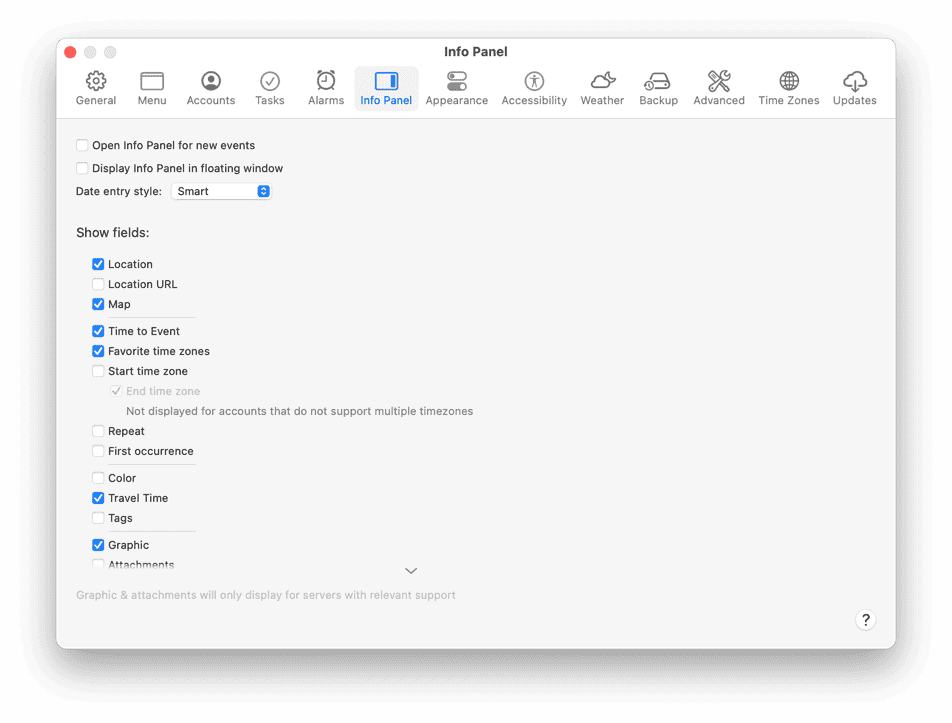
The first two checkboxes affect the display of the Info Panel as a whole:
- Open Info Panel for new events” at the top — If you select this checkbox and the righthand sidebar is visible, then when you create a new event, the title field is selected in the Info Panel. If “Open Info Panel for new events” is selected and the righthand sidebar is not visible when you create a new event, the Info Panel popover (or floating window, depending on the state of the next checkbox) appears, with its title field selected.
- Display Info Panel in floating window — If you select this checkbox, BusyCal displays the Info Panel as a floating window rather than as a popover when the righthand sidebar is not visible.
To choose which fields to display, select from the following options:
- Location — Displays a text field for entering location information.
- Location URL — Displays a URL field for entering location URLs, such as a link to Google Maps.
- Start time zone — Displays a time zone menu for the event start time. See Time Zones for more information.
- End time zone — Displays a time zone menu for the event end time. See Time Zones for more information.
- First occurrence — Displays the first occurrence date of a repeating event and current sequence number.
- Travel time — Displays a menu enabling you to see or specify the travel time for that event.
- URL — Displays a URL field for inserting links.
- Tags — Displays a field for entering tags. See Tags for more information.
- Graphic — Displays a field for attaching graphics. See Graphics for more information.
- Attachments — Displays a menu for attaching files.
- Attendees — Displays a field for adding attendees. See Meetings and Invitations for more information.
- Contacts — Displays a field for linking to contacts in BusyContacts.
- Private — Displays a checkbox to indicate that the event is Private. When sharing a calendar with others through Exchange, Google, and some CalDAV Servers, events marked Private appear to other people with a title of “Private Event.” The event blocks your free time for scheduling purposes, but no other details are shared. Note that only timed-events can be made private.
This checkbox is enabled only when syncing with a calendar server that supports this feature. It is not supported by iCloud.
- Busy — Displays a checkbox to indicate whether an event affects your availability as free or busy.
- Created time — Displays the date and time the event was created.
- Last edit time — Displays the date and time the event was last modified and the user account that last modified it.
- My alarms — Private alarms that are stored locally and do not sync with other apps and services.
- My tags — Private tags that are stored locally and do not sync with other apps and services.
- My URL — Private URLs that are stored locally and do not sync with other apps and services. You can drag files, email messages, bookmarks, contacts, and other items to the my URL field to create links that open the source document.
- My notes — Private notes that are stored locally and do not sync with other apps and services.
Below is an example of the Info Panel with all fields displayed. Any fields unchecked in this settings screen will remain hidden unless the event contains a value for that property. You can also click the down-arrow button below the Info Panel at any time to expand and reveal hidden fields as needed.
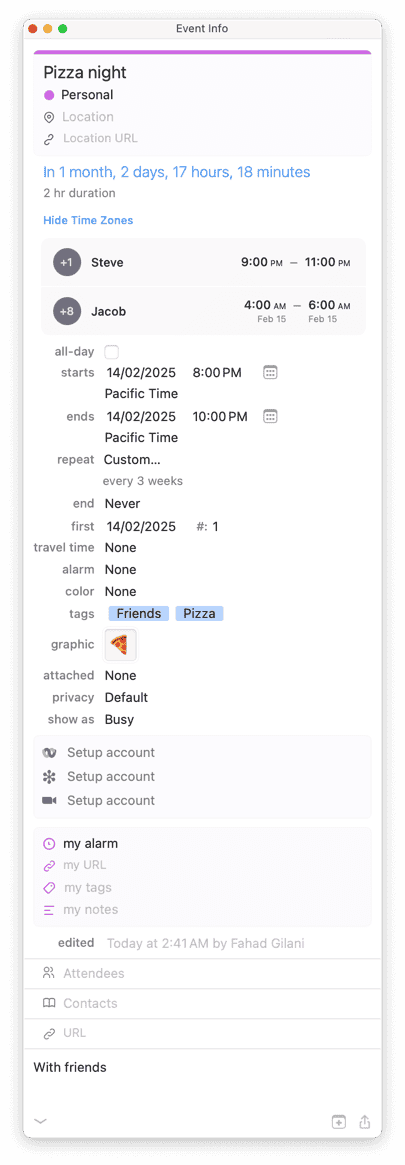
Appearance
To customize the calendar date and event formatting, click Appearance.
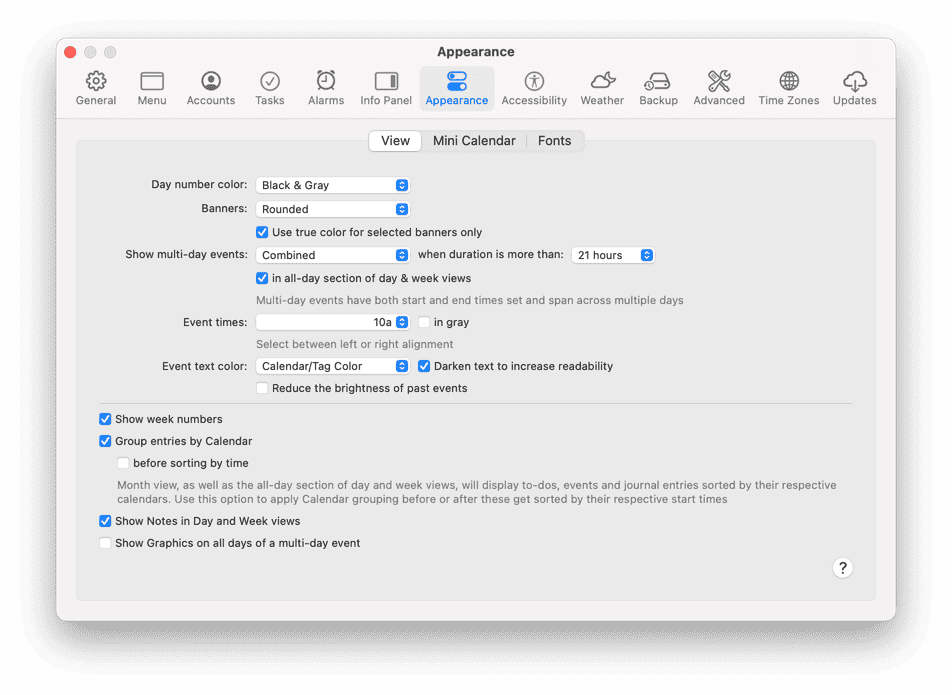
The appearance settings allow you to customize various aspects of the calendar. The settings have been further divided into View, Mini Calendar (the small calendar that displays below the left side panel), and Fonts.
Some notable options are:
- Day number color — The color used for dates in Week/Month/Year view. If you choose Black & Gray or Black & Red, black is used for weekdays while gray or red is used for weekends and holidays.
- Banners — Display style for Banners (all-day events).
- Use true color for selected banners only — Turn this setting off to see more vivid (true) colors for all-day banners, as well as multi-day timed events.
- Show multi-day events — Display style for timed events (i.e. non-all day events), that start on one day and then end on another. For example, a conference call that starts at 9pm on Sunday and ends at 3am on Monday is a "multi-day event". You can choose to show them separated, as separately shown events on each day, or similar to all-day banners.
Combined:
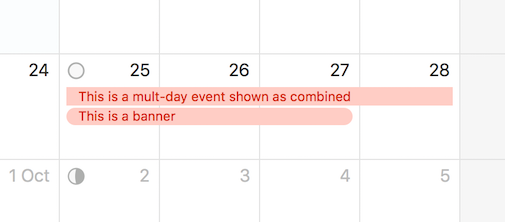
Separated:
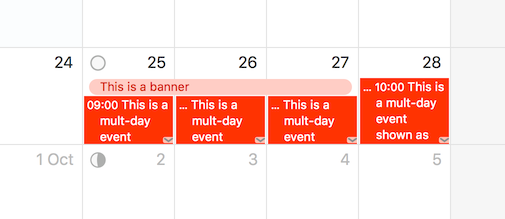
-
When duration is more than — When set to Combined, you can choose to ignore combining events that are shorter than the selected duration.
-
in all-day section of day & week views — When set to Combined you can exclude these from the all day section of day and week views.
-
Event times — The formatting for event times in the Month view. There are several different time formats to choose from. The menu is divided into two sections—one for displaying the event times on the left, and the other for displaying event times on the right. If you tend to have lots of events with long titles, you may want to choose a compact time format (such as 10a) and experiment with left or right justification. Turning Word Wrap off can help fit more events in Month view too.

Select “10:00 AM - 12:00 PM” or “10 AM - 12 PM” if you want to view both the start and end times for each event.
- Event text color — Choose Black to display event names in black in all calendar views, or choose Calendar/Tag Color to display events in the calendar color or tag color. When the event color is black, bullet characters appear next to event names in Month and List views with the color of the calendar or tag.
- Default event font — The font face and size for events.
- Default sticky font — The font face and size for sticky notes.
- Calendar list font — The font face and size for calendar names in the Calendar List shown in the left sidebar.
- Show week numbers — Display week numbers in the calendar and mini months.
- Group entries by Calendar — Events and Tasks can be grouped by calendar first before sorting these by their respective times.
- Show Notes in Day and Week Views — Display notes for events in Day and Week views.
Changing Fonts
Fonts used within the calendar and other parts of the app can be adjusted easily as well.
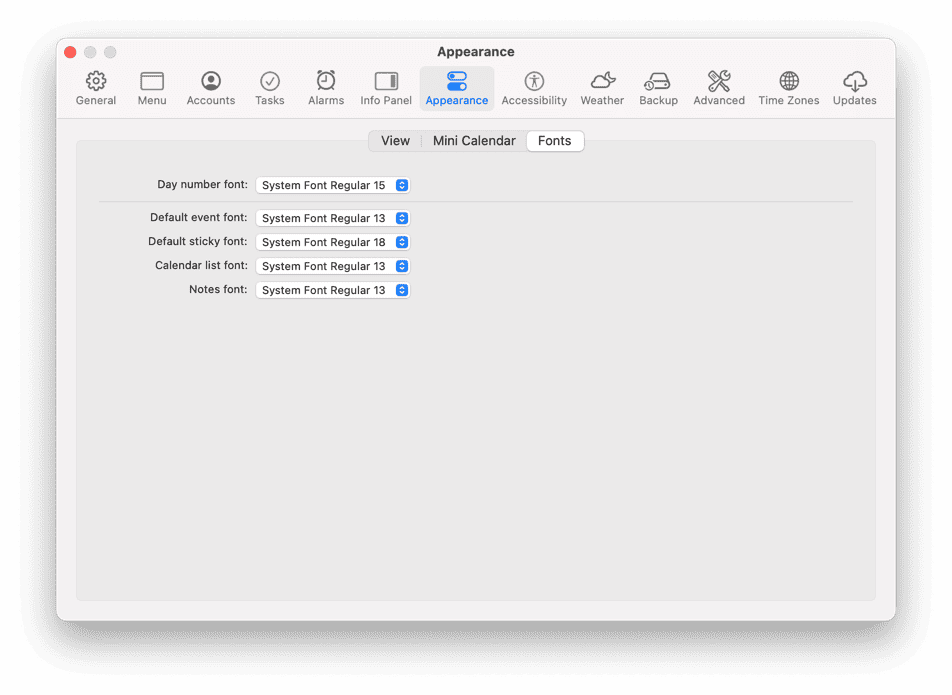
- Day number font — The font face and size for dates and days of the week in Week/Month view.
- Default event font — The font face and size for all events / tasks / journals in week / month view.
- Default sticky font — The font face and size for all sticky notes
- Calendar list font — The font face and size used for displaying calendar names in the left side panel.
- Notes font — The font face and size used for displaying notes for each event in the info panel
Further appearance related settings can be found under the Accessibility Settings.
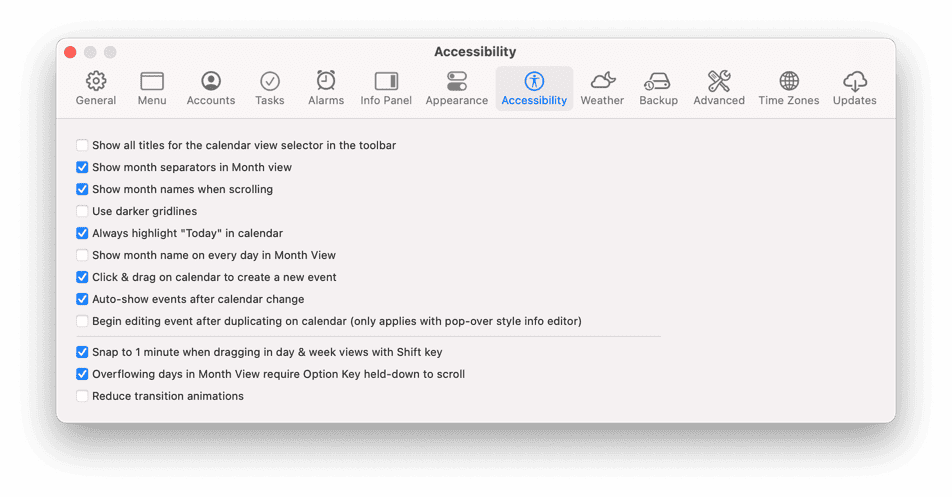
Some notable options:
- Show Graphics on all days of a multi-day event — Timed events that start and end on different days (i.e. non all-day banners) with attached graphics typically only display the icon on the first day. Enabling this option will show an icon on all the days the event spans across.
- Show month separators in Month View — Display a more visible, thick outline to separate days between adjacent months.
- Use darker gridlines — Gridlines in day, week and month views will appear in a darker color.
- Always highlight Today — Make today's date standout by displaying a highlight border around it.
- Show month name on every day in month view — Month view will display the month's abbreviated name on every day.
Weather
To adjust the display of weather, or moon phases on your calendar, click Weather.
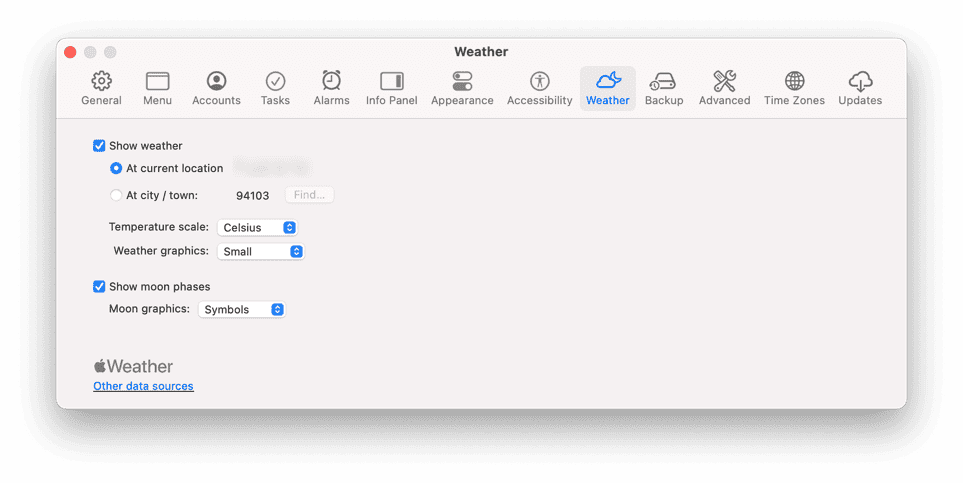
To display weather forecasts for the next 7 days, select the Show weather checkbox, and then select At current location or manually enter the ZIP code or city code for your area. You can also choose Fahrenheit or Celsius from the Temperature scale pop-up menu.
To display weather at your current location, BusyCal requires access to Location Services. The first time you open BusyCal you should be presented with a dialog asking if you want to grant BusyCal permission to access Location Services. If you did not grant BusyCal access to Location Services at that time, you must do so manually, by going to System Settings > Security & Privacy > Privacy > Location Services and then selecting the checkbox next to BusyCal.
Weather Graphics
You can display the weather graphics in three different formats: Small, Large, or Background; choose your desired size from the “Weather graphics” pop-up menu. When the size is set to Small or Large and you hover your pointer over the weather icon, an extended forecast is displayed. If you click the icon you’re redirected to Wunderground.com.
Weather Graphics: Small
Weather Graphics: Large
Weather Graphics: Background
Moon Phases
To display moon phases, select the “Show moon phases” checkbox in Weather Settings.
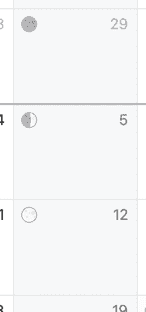
You can display the moon phases in three different formats: Realistic, Symbols, or Astrological; choose your desired format from the “Moon graphics” pop-up menu.
Moon Graphics: Realistic
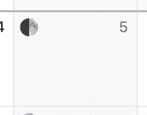
Moon Graphics: Symbols
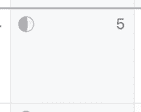
Moon Graphics: Astrological

Backup
BusyCal automatically backs up your calendars every 24 hours and saves your last 10 backups. You can restore entire calendars and all its events or individual events / tasks. Please see Backup & Restoring for more information.
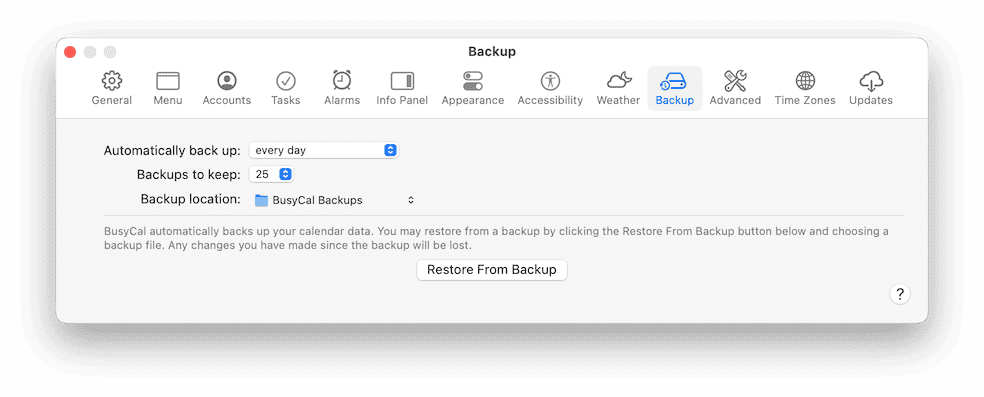
Advanced Calendar Settings
A number of advanced calendar configuration options are found on the Advanced settings pane. These settings allow you to customize BusyCal's behavior for meeting invitations, travel time, natural language processing, general sync options, and more. The Advanced settings are organized into four categories: Meetings, Locations, Sync & LAN, and Other.
advanced calendar settings, busycal advanced options, calendar advanced configuration, advanced preferences busycal, calendar power settings, meeting settings, email settings calendar, calendar advanced tab, calendar configuration options, expert calendar settings, busycal power user settings, advanced settings tab, meetings locations sync other, travel time, auto travel time
Meetings
The Meetings tab contains settings related to meeting invitations, conference calls, and how BusyCal handles meeting-related notifications.
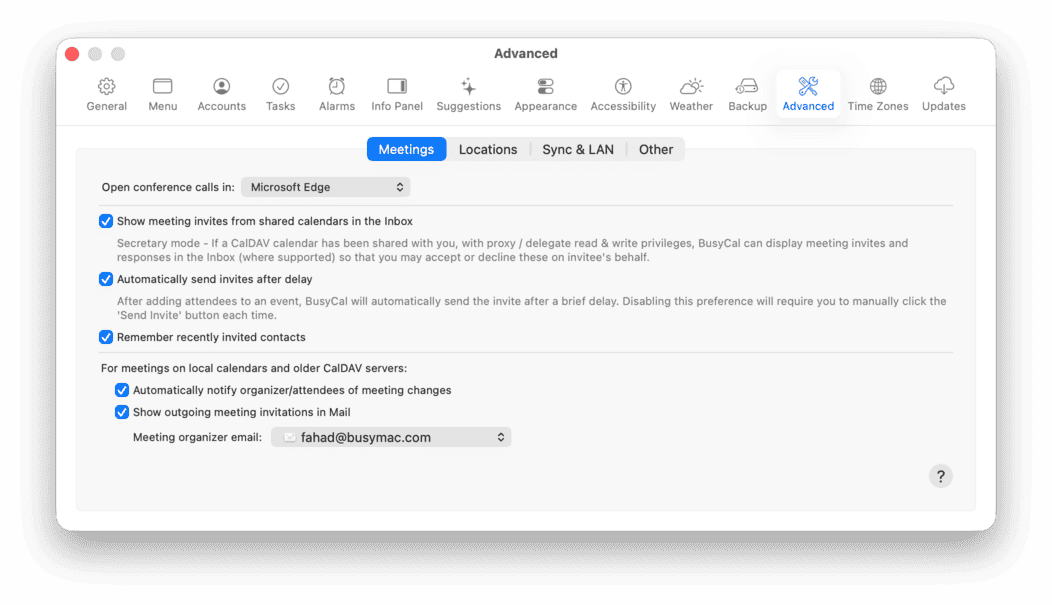
-
Open conference calls in — Choose your preferred application for opening conference call links. You can select from available browsers or conferencing applications installed on your Mac.
-
Show meeting invites from shared calendars in the Inbox — Typically you don't want to see invites sent to people that are sharing their calendars with you, since these aren't explicitly addressed to you. Such meetings would still appear in the calendar - but not as a notification in the Inbox. However, if you're managing someone else's calendar for them (such as an assistant or a secretary), you would want to turn this option ON. This would route all invites, sent to people that have given you read and write permission on a shared calendar, to the Inbox as notifications.
-
Automatically send invites after delay — After adding attendees to an event, BusyCal will automatically send the invite after a brief delay. Disabling this preference will require you to manually click the 'Send Invite' button each time.
-
Remember recently invited contacts — Keep track of contacts you've recently invited to meetings, making it easier to invite them again in the future.
The options under For meetings on local calendars and older CalDAV servers apply to:
-
Local On My Mac calendars that are not connected to a cloud service.
-
Older or self-hosted CalDAV servers that lack the ability to send and receive meeting invitations.
-
Automatically notify organizer/attendees of meeting changes — Select this option to automatically notify attendees when you edit or delete a meeting they were invited to. If this option is deselected, an alert will be presented after editing a meeting asking if you'd like to notify attendees.
-
Show outgoing meeting invitations in Mail — If you select this checkbox, you can view outgoing meeting invitations in Mail before sending them. This may be useful for adding a personal note to the email or changing the mail account the invitation is being sent from.
-
Meeting organizer email — When you create a meeting in BusyCal, your default email address is used for the Organizer. You can change the default Organizer email by choosing one of your email addresses from this pop-up menu. You can select any of the email addresses on the Me card in Contacts.
For meetings created on iCloud, Google, or Outlook/Exchange calendars, invitations are sent automatically by the server during sync—not by your email client. These settings only apply to meetings created on local On My Mac calendars, where invitations are sent via your Mac's email client.
If you're using an account like iCloud or Fastmail, which supports email aliases, you can modify the meeting organizer's email by going to Accounts settings, selecting the account, and updating the Meeting Organizer's Email field.
If you create a meeting on a local calendar, BusyCal sends meeting invitations from the default email account in Apple Mail. You can set the default account in Mail by choosing Mail > Settings > Composing, and choosing an account from the "Send new messages from" pop-up menu. BusyCal also supports several third-party mail clients that allow sending meeting invitations via AppleScript.
Locations
The Locations tab allows you to configure how BusyCal handles location information in events, including map integration and travel time calculations.

-
Open maps in — Choose your preferred map application for opening location links. Options include Google Maps, Apple Maps, and other mapping applications installed on your Mac.
-
Default Origin for Travel Time — Select the default starting point for calculating travel time to events with locations. You can choose from:
- Current or Recent Location — Uses your current location or most recent known location
- Home — Uses your home address from Contacts
- Work — Uses your work address from Contacts
- Custom Location — Allows you to specify a custom address
-
Add Travel Time When Location Is Set — Automatically adds travel time based on your preferred travel mode whenever a location is set for an event. Availability may vary by destination and travel type. Supported only by calendars that allow travel time.
Sync & LAN
The Sync & LAN tab contains settings for syncing BusyCal data across your devices using iCloud and sharing calendars on your local network.
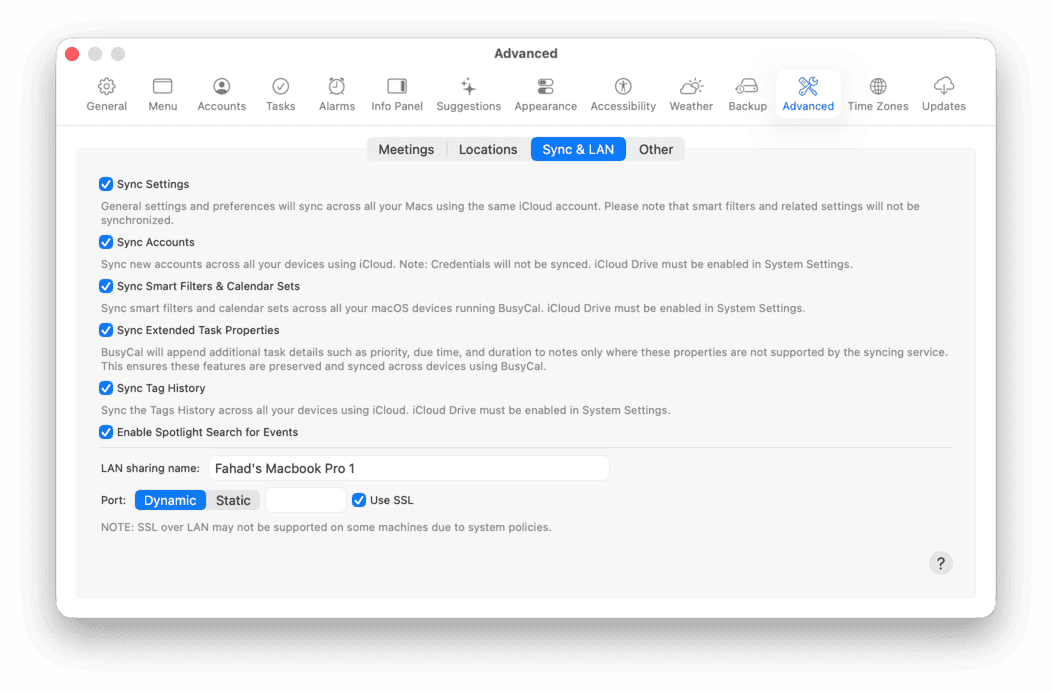
-
Sync Settings — General settings and preferences will sync across all your Macs using the same iCloud account. Please note that smart filters and related settings will not be synchronized.
-
Sync Accounts — Sync new accounts across all your devices using iCloud. Note: Credentials will not be synced. iCloud Drive must be enabled in System Settings.
-
Sync Smart Filters & Calendar Sets — Sync smart filters and calendar sets across all your macOS devices running BusyCal. iCloud Drive must be enabled in System Settings.
-
Sync Extended Task Properties — BusyCal will append additional task details such as priority, due time, and duration to notes only where these properties are not supported by the syncing service. This ensures these features are preserved and synced across devices using BusyCal.
-
Sync Tag History — Sync the Tags History across all your devices using iCloud. iCloud Drive must be enabled in System Settings.
-
Enable Spotlight Search for Events — Allow macOS Spotlight to search and index your calendar events for quick system-wide searching.
LAN Sharing
The LAN sharing preferences apply to sharing calendars with other BusyCal users on a LAN (local area network):
-
LAN sharing name — The name your Mac uses for calendar sharing on your local network.
-
Port — The port used for calendar sharing. Choose between:
- Dynamic — Let BusyCal automatically choose an available port
- Static — Manually specify a port number for consistent network configuration
-
Use SSL — Enable SSL encryption for secure LAN sharing connections.
SSL over LAN may not be supported on some machines due to system policies.
For more information on LAN sharing, see Sharing calendars and address books on a LAN via Bonjour.
Other
The Other tab contains miscellaneous advanced settings for natural language processing, confirmation dialogs, and usage statistics.
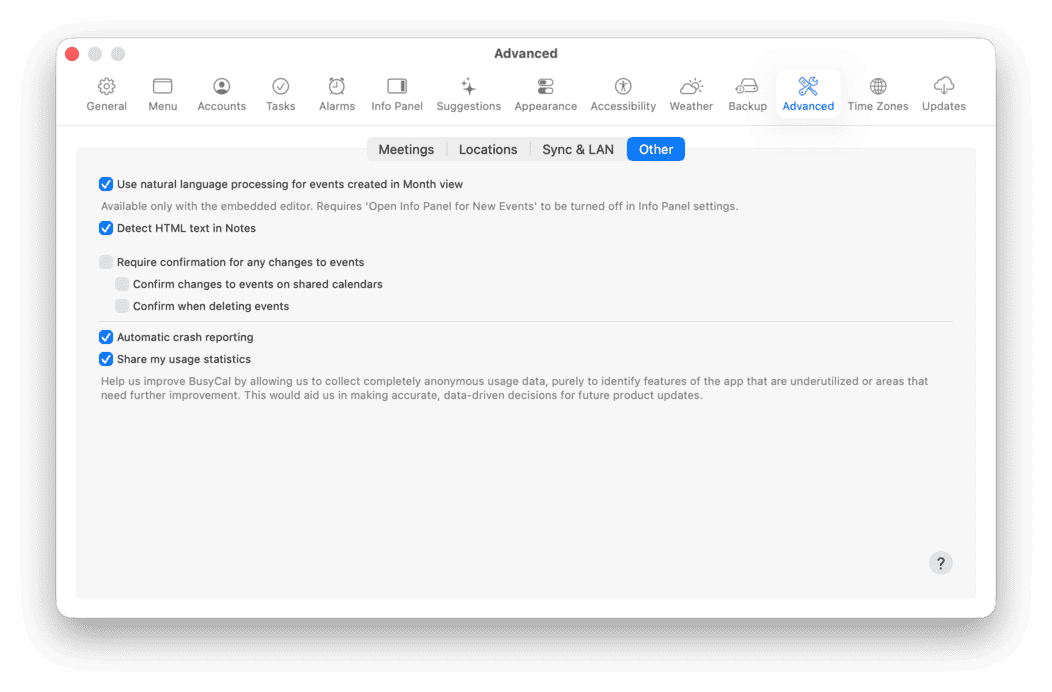
-
Use natural language processing for events created in Month view — When this option is turned on, any time you create a new event in Month view, BusyCal can use NLP Natural Language Processing to automatically extract and set the title of the event, its start/end times, as well as location. Available only with the embedded editor. Requires 'Open Info Panel for New Events' to be turned off in Info Panel settings.
-
Detect HTML text in Notes — Automatically detect and render HTML formatted text in event notes fields.
-
Require confirmation for any changes to events — Display confirmation dialogs for all event modifications:
- Confirm changes to events on shared calendars — Select this option to display a warning when you edit or delete an event on a shared calendar.
- Confirm when deleting events — Show a confirmation dialog before permanently deleting any events.
-
Automatic crash reporting — Automatically send crash reports to help improve BusyCal's stability and performance.
-
Share my usage statistics — Help us improve BusyCal by allowing us to collect completely anonymous usage data, purely to identify features of the app that are underutilized or areas that need further improvement. This would aid us in making accurate, data-driven decisions for future product updates.
Time Zones
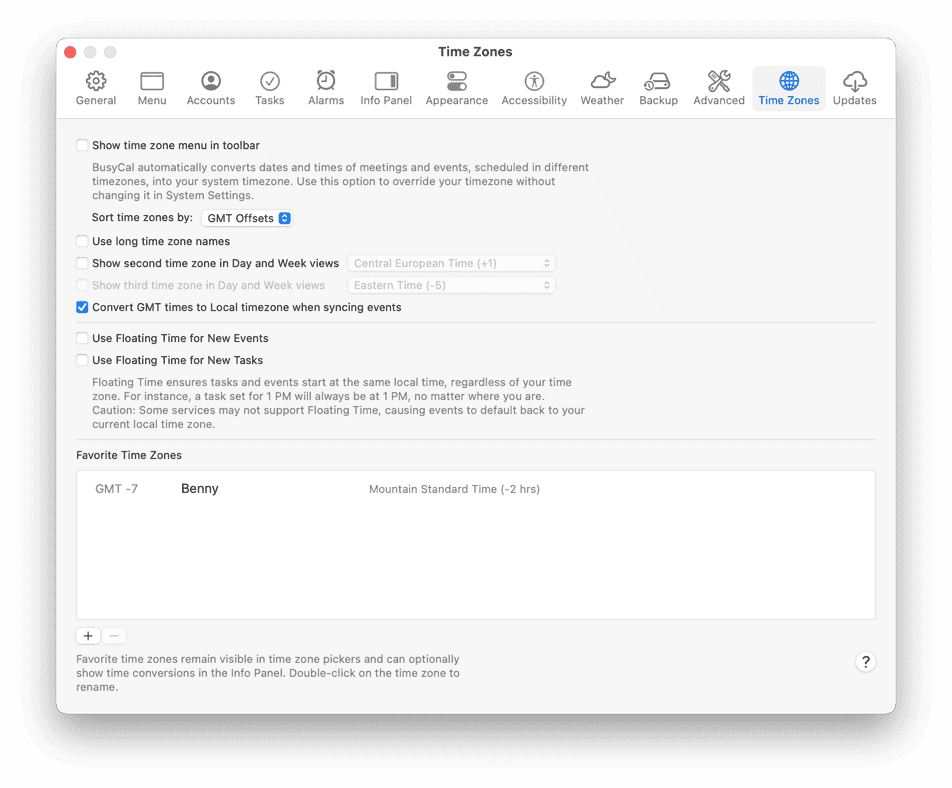
-
Show time zone menu in toolbar — Select this checkbox to enable BusyCal's Time Zone menu, which can be used to dynamically display all the events in your calendar in a different time zone. This is useful when traveling between different time zones. It enables your Mac’s system clock to be set to a new time zone, while BusyCal continues to display events in your home time zone.
-
Use long time zone names — Select this checkbox to display a city name along with the time zone.
-
Show second time zone in Day and Week views — Select this checkbox to display a second time zone bar in day and week views
-
Show third time zone in Day and Week views — Select this checkbox to display a third time zone bar in day and week views
-
Convert GMT times to Local timezone when syncing events — This instructs BusyCal to convert any event with "GMT" set as its timezone to your local time when adding a new event for the first time. Normally, meeting invites or events on shared calendars are added in "GMT" by others as a matter of convenience, as it's easier to reason in GMT time. Such events will automatically get converted to your local date and time. If you would like to keep these in "GMT" time irrespective, uncheck this option. NOTE: The info panel will always show you the actual start / end times along with their respective original timezones, however the day / week / month views will automatically translate these times to your local timezone or one you've manually picked using the Timezone dropdown.
-
Use Floating Time for New Events — Select this checkbox to always use the
Floating Time Zonefor new events. See Time Zone for more information. -
Use Floating Time for New Tasks — Select this checkbox to always use the
Floating Time Zonefor new tasks. See Time Zone for more information.